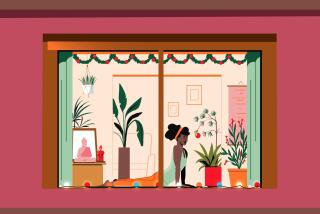Computer Pad Maker Saw Her Business Click Via ‘E-Mail’ Bonding : Technology: San Juan Capistrano businesswoman met her future designer--based in London--via an on-line discussion group.
- Share via
SAN JUAN CAPISTRANO — For the first six months of 1993, Debra Cohen had only a virtual business relationship with the London-based designer who drew pizzas and dinosaurs for her products--decorative computer mouse pads and keyboard wrist rests.
Before he flew to the United States for a trade show, Cohen knew Jonathan Humphrey only through the on-line discussion group on which they “met” in December, 1992.
But when they shook hands at Los Angeles International Airport, Cohen said, she was already confident that she and Humphrey had a similar vision for the product’s look.
“It was the weirdest thing when he walked up, it was like we were old friends,” Cohen said.
With Humphrey’s help, Cohen’s company, Mad Mats in San Juan Capistrano, shipped 150,000 computer mouse pads last year and 5,000 wrist rests, foam pads meant to ease typing strain.
Cohen sells both products through retailers like Fry’s Electronics at $14.99 each, and hopes to double the privately-held company’s revenues in 1995.
Exchanging text and drawings over CompuServe Inc.’s on-line network, Cohen and Humphrey at first focused on creating mouse pads printed with pictures of pizzas, hot dogs and cows. Pads allow personal computer users to control computer mice--a hand-held pointing device--with greater precision.
Wrist rests in shapes such as limousines and human arms came later, after Cohen pondered what to do with some scrap foam from the mouse pad that was sitting on her desk.
*
Medical researchers are still uncertain about whether any aids will help typists with heavy workloads avoid overuse injuries. Mad Mats’ packaging includes the warning “Absolutely No Medical Benefit Implied,” but anything that makes users more comfortable can only help, Cohen said.
Though they sent each other text and designs daily, both Cohen and Humphrey said it wasn’t until they met face-to-face that either felt they had established a serious business relationship. But having met by e-mail did make it easier to jump into the first project, Humphrey said.
“You have a sense of security with them,” Humphrey said in a telephone interview from England. “You find out things about people, just from their voice when you’re speaking on the phone, that you don’t when you’re typing.”
“You don’t have as many preconceived ideas about them,” he said. “I think they’ve told you more (by text) about themselves than they might not have on the phone.”
Creative partnerships like Mad Mats can only become more common as computer networks blur the boundaries between commercial and social interactions, said Karen Heyman, a communications consultant based in Santa Monica.
“People on-line aren’t doing anything they wouldn’t do in real life. It’s much the way you go to a party and don’t expect any business to happen, and then you meet somebody who says, ‘Oh my God, my sister-in-law’s in that business,’ and suddenly there might be a deal for somebody,” Heyman said.
“What’s different is that instead of the people being from Marina del Rey and Malibu, now they’re from Italy and Ohio,” she said.
*
With about $25,000 that she and her husband, Jeffrey, had made from a Newport Beach veterinary hospital they own, Cohen founded Mad Mats after dropping out of an evening MBA program at Pepperdine University.
Printing and manufacturing work on the foam products is contracted out, though Cohen and eight part-time workers handle the final packaging and shipping tasks from the company’s administrative office.
She said she was swamped with interest from the first time she put the mouse pads on display at a trade show, but was misled by buyers from several large chains.
“If there was one big mistake I made, it was to begin production without having a firm order,” Cohen said. When she called one company to complete what she thought would be final paperwork, Cohen said she was told the buyer no longer worked there and that her replacement wasn’t interested in completing the purchase.
Another error, Cohen believes, was in initially offering too many designs. “Sometimes when you offer people too much choice, they can’t buy at all,” she said. “You could tell who those buyers were when they called and asked what our top sellers were, and then they’d just order those.”
“I also made the mistake of telling them the truth about what sold well,” she said. “Then we couldn’t keep them in stock!”
Mad Mat’s best-selling mouse pad is one printed with a muscular male torso, she said.
(BEGIN TEXT OF INFOBOX / INFOGRAPHIC)
Why Wrist Rests?
Used correctly, ergonomic aids like wrist rests can make using a computer more comfortable and prevent injury. Some tips on wrist rests:
Proper use: Use only during pauses, not while typing. Wrists should hover slightly above the rest while using the keyboard. Typing with wrists lying on rest places external pressure on sensitive carpal tunnel area and can lead to soreness.
Other benefits: Wrist rests also help prevent tightness in shoulder and neck areas by minimizing the static load that typing places across shoulder area.
Material: Should be upholstered or made of a cushioned substance, such as foam rubber.
Height, width: Should be level with home row keys and wide enough (3-4 inches) to rest entire wrist area.
Exercise breaks: Pause frequently. Circle hands in both directions to keep wrists limber. Do shoulder shrugs to loosen tension.
Source: Joyce Institute, a unit of Arthur D. Little; Researched by JANICE L. JONES / Los Angeles Times
More to Read
Inside the business of entertainment
The Wide Shot brings you news, analysis and insights on everything from streaming wars to production — and what it all means for the future.
You may occasionally receive promotional content from the Los Angeles Times.










